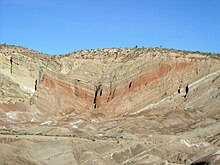

The Barstovian North American Stage on the geologic timescale is the North American faunal stage according to the North American Land Mammal Ages chronology (NALMA), typically set from 16,300,000 to 13,600,000 years BP, a period of 2.7 million years.[1] It is usually considered to overlap the Langhian and Serravallian stages of the Middle Miocene. The Barstovian is preceded by the Hemingfordian and followed by the Clarendonian NALMA stages.
The Barstovian can be further divided into the substages of:
- late Late Barstovian: Lower boundary source of the base of the Langhian (approximate)
- early Late Barstovian: Base of the Langhian (approximate)
- early/lower Barstovian: Upper boundary source: base of Clarendonian (approximate)
Correlations
[edit]The Barstovian (15.97 to 13.6 Ma) correlates with:
- SALMA
- Colloncuran (15.5-13.8 Ma)[2]
- earliest Laventan (13.8-11.8 Ma)[3]
- ELMA - Astaracian (15.97-11.608 Ma)[4]
- Mammal Neogene Units, European Faunal Zones
- CPS[6]
- New Zealand stratigraphy - Southland epoch (15.9-10.92 Ma)[8]
- Clifdenian (15.9-13.65 Ma)[9]
- earliest Lillburnian (13.65-12.7 Ma)[10]
- NMAC
- Shanwangian (16.9-13.65 Ma)[11]
- earliest Tunggurian (13.65-11.1 Ma)[12]
References
[edit]- ^ Paleobiology Database, Barstovian
- ^ Colloncuran at Fossilworks.org
- ^ Laventan at Fossilworks.org
- ^ Astaracian at Fossilworks.org
- ^ MN 5 zone at Fossilworks.org
- ^ Central Paratethys Stages at Fossilworks.org
- ^ Badenian at Fossilworks.org
- ^ Southland epoch at Fossilworks.org
- ^ Clifdenian at Fossilworks.org
- ^ Lillburnian at Fossilworks.org
- ^ Shanwangian at Fossilworks.org
- ^ Tunggurian at Fossilworks.org
Well, that’s interesting to know that Psilotum nudum are known as whisk ferns. Psilotum nudum is the commoner species of the two. While the P. flaccidum is a rare species and is found in the tropical islands. Both the species are usually epiphytic in habit and grow upon tree ferns. These species may also be terrestrial and grow in humus or in the crevices of the rocks.
View the detailed Guide of Psilotum nudum: Detailed Study Of Psilotum Nudum (Whisk Fern), Classification, Anatomy, Reproduction